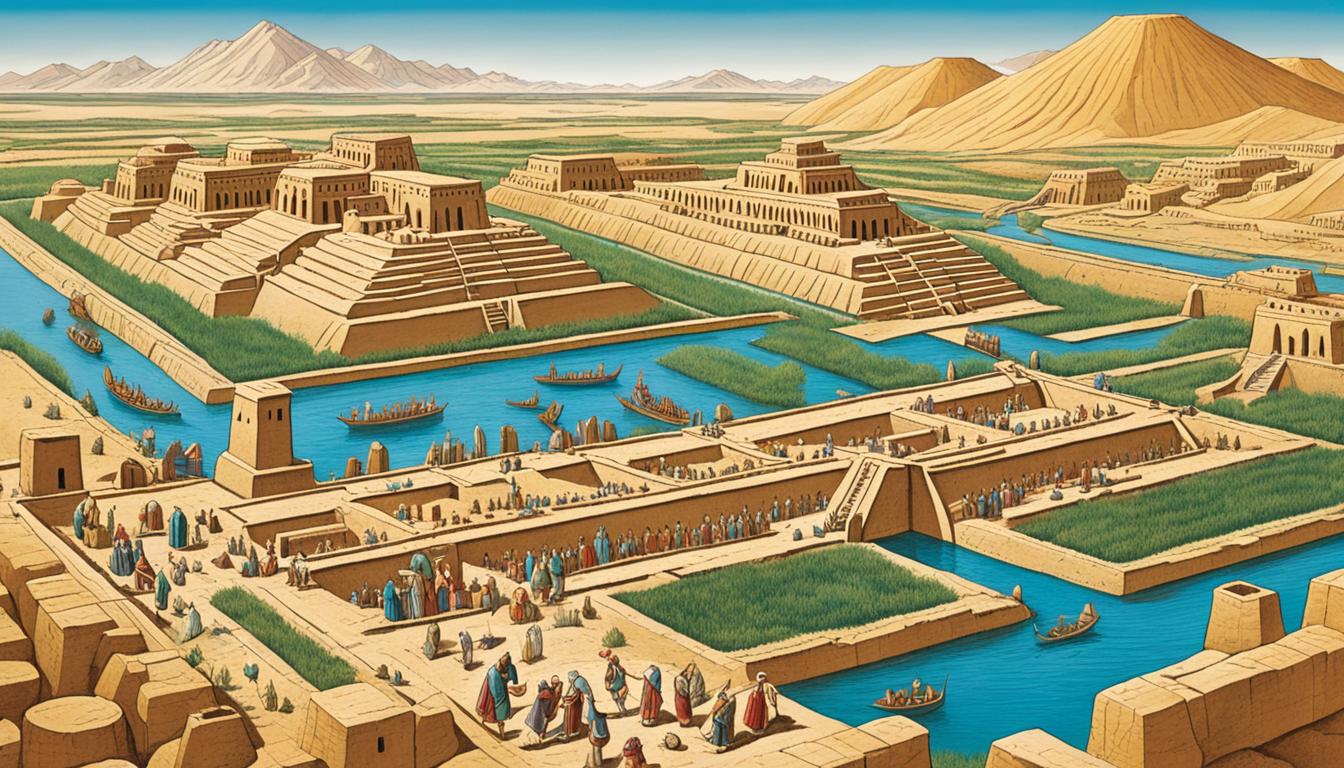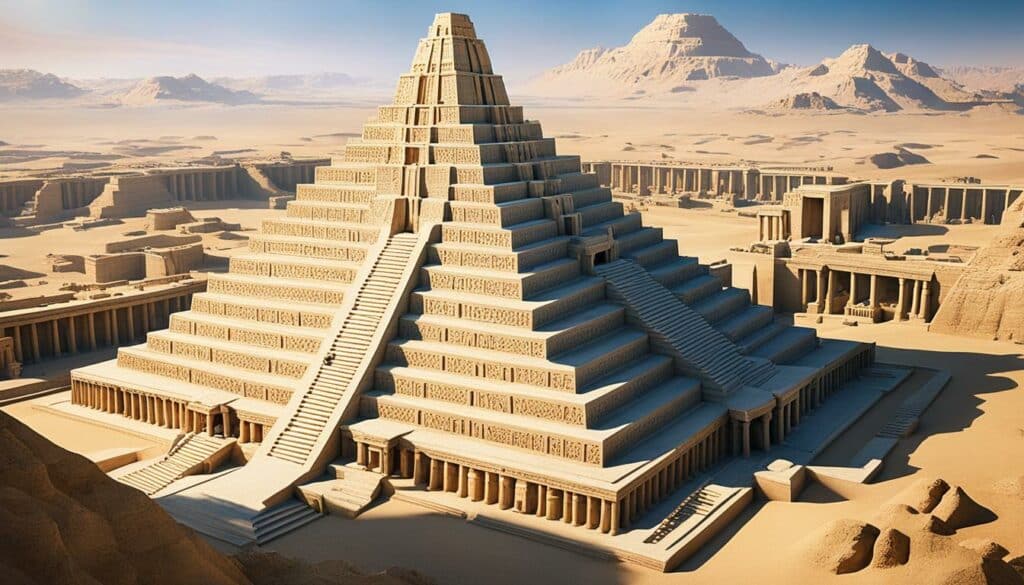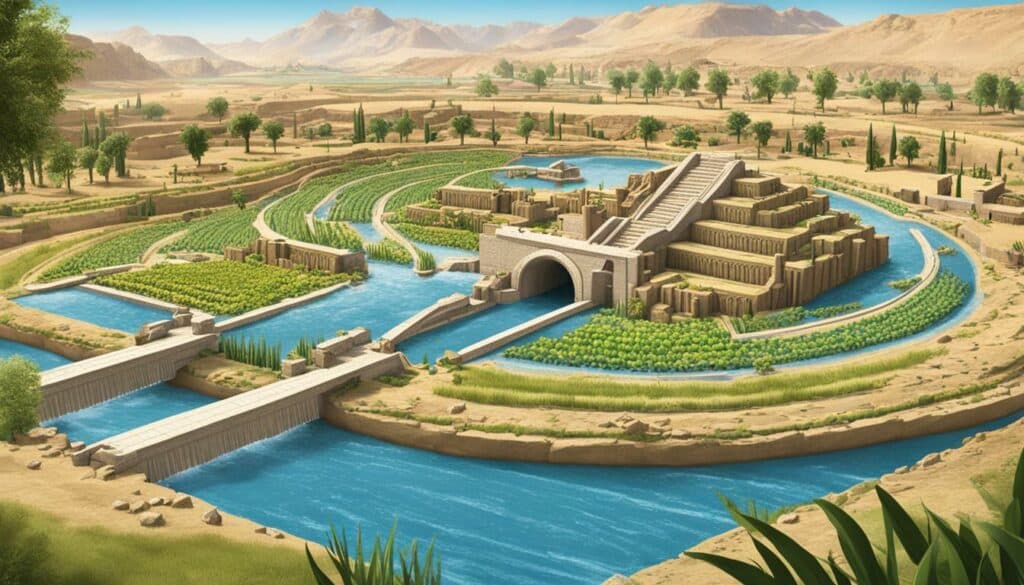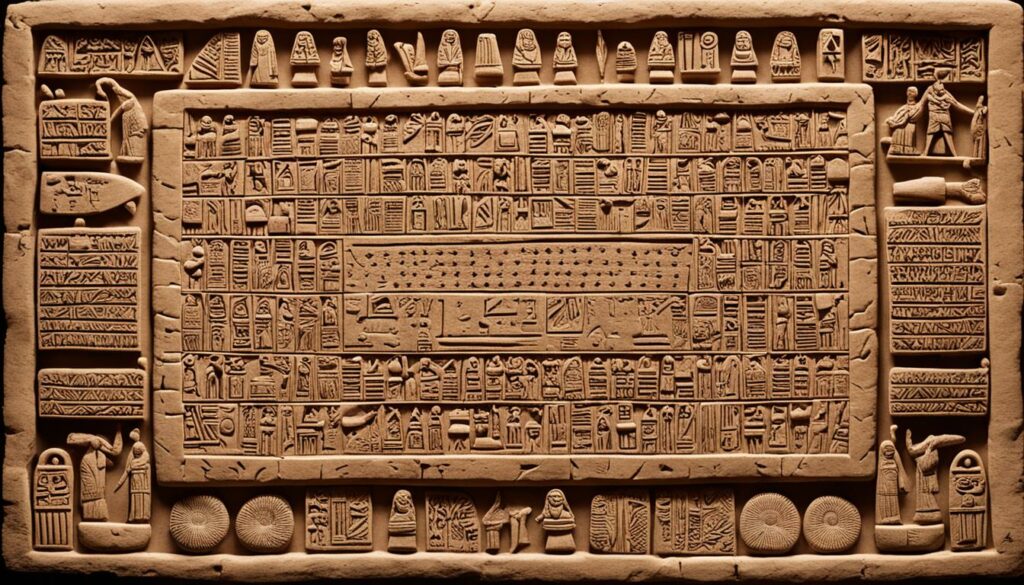
Welcome to our exploration of the remarkable achievements of Mesopotamia, often hailed as the cradle of civilization. Mesopotamia, located in the fertile valleys between the Tigris and Euphrates rivers, witnessed groundbreaking advancements that shaped the world we know today.
Key Takeaways:
- Mesopotamia, known as the cradle of civilization, was a hub of innovation.
- The development of writing and the creation of cuneiform revolutionized communication.
- Mesopotamia’s architectural marvels, such as ziggurats and the Hanging Gardens of Babylon, showcased their engineering prowess.
- Technological innovations, including irrigation systems and the invention of the wheel, transformed agriculture and transportation.
- Legal and administrative systems, exemplified by Hammurabi’s Code, laid the foundation for governance and justice.
Writing System and Literature
One of the most notable achievements of Mesopotamia was the development of writing. They created the earliest known form of writing, known as cuneiform, which allowed for the recording of laws, literature, and historical events.
“Mesopotamia…the invention of writing and the beginning of literature were among the most significant accomplishments of the Sumerians.”
— Samuel Noah Kramer
Mesopotamia’s writing system, cuneiform, consisted of wedge-shaped characters impressed onto clay tablets using a stylus. This writing system enabled the Mesopotamians to document their laws, religious texts, and economic records.
Notably, Mesopotamia produced some of the earliest known works of literature. The Epic of Gilgamesh, a story about a legendary Sumerian king, originated in Mesopotamia and is considered one of the oldest surviving works of literature in the world.
The writing and literature of Mesopotamia played a vital role in preserving their cultural heritage for future generations and formed the foundation for later writing systems and literatures.
Writing System – Cuneiform
The writing system developed in Mesopotamia, known as cuneiform, was groundbreaking for its time. The term “cuneiform” derived from the Latin words “cuneus” meaning “wedge” and “forma” meaning “shape.” This system involved forming wedge-shaped impressions on clay tablets to represent different sounds, words, and ideas.
Cuneiform was used primarily for administrative purposes, legal records, economic transactions, and religious texts. It consisted of several hundred different signs that evolved and became more complex over time as the writing system developed.
The invention of the cuneiform writing system marked a significant advancement in human communication and laid the groundwork for future writing systems around the world.
| Advancements in Writing and Literature | Achievements |
|---|---|
| Development of cuneiform writing system | Recorded laws, literature, and historical events |
| Production of the Epic of Gilgamesh | One of the oldest surviving works of literature |
Architectural Marvels
Mesopotamia, the cradle of civilization, boasts remarkable architectural marvels that showcase its historical and cultural achievements. One of the most iconic structures is the ziggurat, a towering stepped temple built to honor the gods and serve as an essential religious and administrative center.
The ziggurats in Mesopotamia were grand in scale and design, featuring multiple levels that symbolized the connection between heaven and earth. These monumental structures were not only a physical representation of religious devotion but also played a vital role in the community, functioning as a gathering place for rituals, ceremonies, and administrative affairs. The ziggurats were a testament to the architectural ingenuity and the religious significance of Mesopotamia.
Another architectural wonder associated with Mesopotamia is the legendary Hanging Gardens of Babylon. Although their existence remains a subject of debate, these gardens were considered one of the Seven Wonders of the Ancient World. The Hanging Gardens were believed to be a verdant oasis suspended in the air, adorned with a variety of plants, trees, and cascading waterfalls. They were a testament to the advanced engineering and horticultural skills of the Mesopotamians.
“The ziggurats and the Hanging Gardens of Babylon exemplify the remarkable architectural achievements of Mesopotamia, captivating our imagination and showcasing the cultural legacy of this ancient civilization.”

The architectural marvels of Mesopotamia not only symbolized religious devotion and cultural significance but also left a lasting impact on the architectural styles of later civilizations. They served as architectural predecessors, inspiring future cultures to incorporate similar design elements and concepts.
Overall, the architectural accomplishments of Mesopotamia remain a testament to the ingenuity and artistic prowess of this ancient civilization, showcasing their historical achievements and cultural contributions.
Technological Innovations
Mesopotamia, the cradle of civilization, was a hotbed of technological innovation. The ancient Mesopotamians made remarkable advancements that revolutionized various fields, leaving a lasting impact on human history. Let’s explore some of their incredible achievements and contributions.
Irrigation Systems
The Mesopotamians developed highly sophisticated irrigation systems to cultivate the land and enhance agricultural productivity. They built canals and reservoirs to control the flow of water and distribute it to their fields. This breakthrough allowed them to grow crops more efficiently, leading to abundant harvests and a stable food supply. The technological innovation of irrigation systems played a crucial role in sustaining the population and fueling the growth of Mesopotamian civilization.
The Invention of the Wheel
One of the most significant technological inventions by the Mesopotamians was the wheel. This revolutionary device revolutionized transportation and trade. Mesopotamians utilized the wheel for various purposes, including the construction of chariots, carts, and pottery wheels. The wheel transformed the way goods were transported and played a pivotal role in facilitating the exchange of goods and ideas, both within Mesopotamia and across distant regions.
The First Mathematical System
Astonishingly, Mesopotamia was the birthplace of the first known mathematical system. The Mesopotamians developed a sophisticated numerical system based on a sexagesimal (base-60) numeral system. They used this mathematical framework for calculations, measurements, and astronomical observations. The Mesopotamians’ mathematical prowess enabled them to advance their understanding of geometry, arithmetic, and even construct astronomical calendars to predict celestial events.
In conclusion, Mesopotamia’s technological innovations undoubtedly shaped the course of human progress. Their revolutionary irrigation systems, invention of the wheel, and pioneering mathematical system demonstrate the remarkable ingenuity and problem-solving capabilities of this ancient civilization.

Legal and Administrative Systems
Mesopotamia’s significant accomplishments extended beyond cultural and architectural marvels. The civilization stands out for its well-developed legal and administrative systems, which contributed to the stability and organization of the region.
The most notable legal system of Mesopotamia was Hammurabi’s Code, one of the earliest recorded sets of laws. This code provided guidelines for various aspects of life, ensuring fairness and establishing clear boundaries for trade, property rights, and family matters.
“If a man brings an accusation against another, charging him with murder, but does not prove it, the accuser shall be put to death.”
This is just a glimpse of the severity and comprehensiveness of Hammurabi’s Code. It played a central role in shaping subsequent legal systems around the world, making it a significant contribution of Mesopotamia.
In addition to the legal framework, Mesopotamia also had a complex administrative structure. The region comprised several city-states, each with its own ruler or king. These rulers managed the affairs of their respective territories, overseeing various administrative functions such as taxation, infrastructure development, and the enforcement of laws.
The administrative system ensured the efficient functioning of the civilization and fostered stability within Mesopotamia. It allowed for effective governance, contributing to the overall success and influence of the region.
Overall, Mesopotamia’s legal and administrative systems were instrumental in providing structure and order within the civilization. Hammurabi’s Code and the complex administrative structure attest to the significant accomplishments and contributions of Mesopotamia in establishing early legal and governance frameworks.

| Key Features of Mesopotamia’s Legal and Administrative Systems |
|---|
| Hammurabi’s Code: One of the earliest recorded legal systems, providing guidelines for various aspects of life |
| Complex Administrative Structure: City-states and kings ruling over specific regions, managing taxation, infrastructure development, and law enforcement |
Advancements in Education and Science
In Mesopotamia, education held significant value, leading to the establishment of schools dedicated to educating future scribes and priests. This commitment to education fostered a society that valued intellectual growth and knowledge.
Apart from education, Mesopotamians made remarkable contributions to the field of science. Their advancements in astronomy laid the foundation for the study of celestial bodies. By carefully observing the movement of stars and planets, the Mesopotamians developed an understanding of astronomy that allowed them to create accurate calendars and predict phenomena such as eclipses.
Furthermore, the Mesopotamians played a vital role in the development of mathematics. They made great strides in understanding geometry and arithmetic, contributing to the foundation of mathematical principles.
Their observations and calculations paved the way for practical applications in daily life, such as land surveying and the construction of monumental architecture.
Trade and Economic Systems
Mesopotamia, the cradle of civilization, thrived as a bustling center of trade and economic activity. Its strategic location between the Tigris and Euphrates rivers and its abundance of natural resources contributed to its economic prosperity and made it a hub for commerce.
The Mesopotamians engaged in extensive long-distance trade networks, connecting with neighboring regions and exchanging a wide range of valuable goods. They traded in precious metals such as gold, silver, and copper, which were highly sought after for their ornamental and functional uses.
“Mesopotamia was a hub of trade, bustling with activity as merchants and caravans traversed the land, exchanging goods and forging economic connections with distant lands.”
Textiles and garments were another important trade commodity in Mesopotamia. Skilled weavers and craftsmen produced fine textiles made from linen and wool, which were highly prized for their quality and craftsmanship.
Agricultural products also played a significant role in Mesopotamian trade. The region’s fertile soil and advanced irrigation systems made it ideal for producing crops such as barley, wheat, dates, and figs. These agricultural products were traded both locally and internationally, contributing to the economic growth and prosperity of Mesopotamia.
To facilitate trade and commerce, the Mesopotamians developed a sophisticated economic system. They used a variety of currencies, including silver and barley, for trading and conducted transactions using contracts and credit. This system fostered trust and enabled business transactions to take place smoothly.
The Mesopotamians also had marketplaces and trading centers where merchants could buy and sell goods. These bustling marketplaces were vibrant hubs of economic activity, attracting merchants from far and wide to come and engage in trade.
Trade and Economic Achievements in Mesopotamia:
- Long-distance trade networks
- Exchange of precious metals, textiles, and agricultural products
- Sophisticated economic system involving currency, contracts, and credit
- Vibrant marketplaces and trading centers
| Trade Goods | Imported From | Exported To |
|---|---|---|
| Precious metals (gold, silver, copper) | Other regions, such as Egypt and the Indus Valley | Various regions in Mesopotamia |
| Textiles and garments | Neighboring regions, such as Anatolia | Various regions in Mesopotamia |
| Agricultural products (barley, wheat, dates, figs) | Local agricultural regions within Mesopotamia | Various regions in Mesopotamia and beyond |
The trade and economic achievements of Mesopotamia not only contributed to the region’s prosperity but also fostered cultural exchange and connections with distant lands. These accomplishments laid the foundation for future civilizations and continue to shape our modern world.
Conclusion
Mesopotamia, often referred to as the cradle of civilization, has left an indelible mark on human history. Through their pioneering achievements in writing, architecture, technology, law, education, and trade, the people of Mesopotamia laid the foundation for future civilizations to flourish.
The development of writing, particularly the creation of cuneiform, allowed for the preservation of laws, literature, and historical events. Mesopotamia’s architectural marvels, like the ziggurats and the Hanging Gardens of Babylon, showcased their advanced building techniques and cultural significance. Technological innovations like irrigation systems and the invention of the wheel revolutionized agriculture, transportation, and trade.
The legal and administrative systems, exemplified by Hammurabi’s Code, provided structure and guidance for various aspects of life. Education played a vital role in Mesopotamia, with the establishment of schools to educate future scribes and priests. Their contributions to science, especially in astronomy and mathematics, advanced our understanding of the universe and paved the way for the development of calendars and the prediction of celestial events.
Moreover, Mesopotamia’s thriving trade networks and sophisticated economic systems demonstrated their mastery in commerce and resource management. Their achievements and cultural advancements continue to shape our world today, reminding us of the rich legacy inherited from this ancient civilization.
